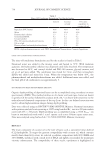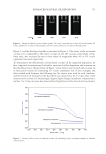741 Address all correspondence to Rebeca Gasparin, rebeca.gasparin@symrise.com Influence of Ethnicity and Damage Levels on Fragrance Substantivity on Hair REBECA M. GASPARIN, FERNANDA M. THOMAZ, CAROLINA B. LOURENÇO, ADELINO K. NAKANO AND ANITA J. MARSAIOLI Global Hair Care Center, Symrise AG, São Paulo, Brazil (R.M.G., F.M.T., C.B.L., A.K.N.) State University of Campinas (Unicamp), São Paulo, Brazil (R.M.G., A.J.M.) Synopsis Product fragrance and performance are crucial for individuals choosing hair care products. Thus, fragrance raw materials should possess physicochemical characteristics that ensure good blooming upon product unpacking and during use and additionally exhibit good substantivity on hair fibers. To investigate the influence of fragrance raw material characteristics, hair damage level, and ethnicity on fragrance substantivity on hair fiber, hairs of different ethnicities were chemically and thermally damaged. Along with this, the level of damage was characterized by attenuated total reflectance Fourier-transform infrared spectroscopy, protein loss evaluation, scanning electron microscopy analysis, tensile test, and swelling test. The substantivity of each fragrance ingredient was evaluated for wet and dry hairs using gas chromatography coupled with mass spectroscopy. Our results indicated that the physicochemical properties of fragrance raw materials (mainly polarity) altered their availability within the shampoo formulation, as well as their substantivity on hair fibers. Furthermore, the substantivity of fragrance compounds was influenced by alterations in hair permeability and hydrophobicity caused by various damaging processes. INTRODUCTION The fragrance of hair care products is an important factor for consumers worldwide. Consumers expect their hair care products to impart a sensation of cleanliness and perfume their hair with a long-lasting scent (1–3). Thus, fragrances used in hair cosmetics should be derived from raw materials that exhibit physicochemical characteristics that ensure good blooming upon product unpacking and during use and also exhibit good substantivity on hair fibers. The physicochemical characteristics of hair fibers can differ between hairs from different ethnicities and can also be altered by chemical, physical, or environmental agents and processes, which transform its naturally hydrophobic and slightly charged surface into a hydrophilic, polar, and negatively charged surface. These modifications change the reactivity of the hair toward external agents and lead to a decrease in the number of cuticular layers, formation of split ends and cracks, breakage and weakening, decreased J. Cosmet. Sci., 72, 741–752 (November/December 2021)
742 JOURNAL OF COSMETIC SCIENCE shine, and the appearance of unhealthy hair (4–7). Therefore, the level of damage in the hair can also interfere with the fragrance substantivity on the fibers (8). In this context, this study aims to improve the understanding of the influence of different factors (fragrance raw materials’ [FRMs] physicochemical characteristics, hair damage level, and hair ethnicity) on the substantivity of FRMs on hair. Hence, we intend to provide information that can be used to deliver unique and personalized products within the hair care industry this is regarded as a real consumer need rather than a trend. MATERIALS AND METHODS HAIR Caucasian, Asian, and African virgin dark brown hair were purchased from International Hair Importers & Products (USA). Hair tresses (5 g, 17–20 cm long) were washed using a 10% sodium lauryl ether sulfate (SLES) aqueous solution (1 g/10 g of hair) for 1 min, rinsed for 1 min under tap water (33 ± 3°C, 4 L/min), and left to dry overnight under controlled conditions (22 ± 2°C and 50 ± 5% relative humidity [RH]). DAMAGE GROUPS Tresses were divided into three damage groups (straightened hair, straightened + thermally damaged hair, and straightened + bleached hair) according to the applied damage procedure. Three tresses from each ethnicity were used for each group. Virgin hair tresses were used as the control. HAIR DAMAGE PROCEDURES Straightening. Tresses were straightened using an ammonium thioglycolate-based formulation (3.5 g/5 g of hair). The product was spread over each tress, and a comb was used to align the fibers the applied product was left on for 25 min. Then, the tresses were rinsed with tap water (33 ± 3°C, 4 L/min) for 3 min. A hydrogen peroxide neutralizer was applied to each tress (2 mL). After 10 min, the neutralizer was rinsed off with tap water (33 ± 3°C, 4 L/min). The tresses were washed thrice with a 10% SLES aqueous solution and left to dry overnight under controlled conditions (22 ± 2°C and 50 ± 5% RH). Bleaching. Hair tresses were bleached using a mixture comprising of one part of commercial bleaching powder (Yamá, BRL) and two parts of hydrogen peroxide emulsion (12%, Yamá, BRL). The bleaching mixture was applied to the hair tresses (13 g/5 g of hair) and homogeneously spread over them. The tresses were individually wrapped in aluminum foil and kept in an oven at 25°C for 45 min. Then, they were rinsed under running water (33 ± 3°C, 4 L/min) until all the product residues were removed. The tresses were washed thrice times with 10% SLES aqueous solution and left to dry overnight under controlled conditions (22 ± 2°C and 50 ± 5% RH). Thermal process. The tresses were flat-ironed 60 times (Nano Titanium, Babyliss Pro, USA) at 230°C, with 30 min intervals between every 10 hot flat-iron passes. Each pass took 5 s on an average. The application force was constant throughout the tress length.
Purchased for the exclusive use of nofirst nolast (unknown) From: SCC Media Library & Resource Center (library.scconline.org)






































































































































